
Introduction
Music streaming services have revolutionized the way people discover and enjoy music. AI technologies play a crucial role in enhancing user experiences by powering recommendation systems that provide personalized music suggestions. In this blog post, we will explore the top five AI technologies used in recommendation systems for music streaming, enabling platforms to offer tailored music recommendations to their users and increase engagement.
Why Use AI Technologies for Recommendation Systems in Music Streaming?
- AI technologies enable personalized music recommendations based on user preferences.
- AI-powered recommendation systems introduce users to new and relevant artists and genres.
- AI continuously learns from user interactions to update music suggestions in real-time.
- Personalized recommendations enhance user engagement and encourage longer platform usage.
- AI automates content curation, saving time and delivering accurate recommendations.
Related Reading:
Here Are Our Top 5 AI technologies for recommendation systems in music streaming:
1: Collaborative Filtering
Overview and Importance
Collaborative filtering is a fundamental AI technology for recommendation systems in music streaming. It leverages user behavior and preferences to suggest music that users are likely to enjoy based on the preferences of similar users. Collaborative filtering plays a vital role in enhancing the user experience by providing personalized music recommendations, leading to increased user engagement and retention.
Learn more about Collaborative Filtering
Key Features and Capabilities
User-Item Interaction Modeling
- Collaborative filtering models analyze user interactions with music items, such as listens, likes, and skips, to build user-item interaction matrices.
User Similarity Computation
- The algorithm calculates the similarity between users based on their behavior patterns, identifying users with similar music tastes.
Item Recommendation
- Collaborative filtering generates personalized music recommendations by suggesting items that similar users have enjoyed, ensuring relevant and engaging content for music streaming users.
2: Content-Based Filtering
Overview and Importance
Content-based filtering is a significant AI technology for recommendation systems in music streaming. It focuses on analyzing the characteristics of music items, such as genres, artists, and lyrics, to suggest similar items to users based on their preferences. Content-based filtering enhances user engagement by providing personalized music recommendations aligned with individual tastes and preferences.
Learn more about Content-Based Filtering
Key Features and Capabilities
Item Profile Creation
- Content-based filtering builds profiles for music items by extracting features like genre, artist, and album information.
User Profile Modeling
- The system constructs user profiles based on their historical interactions and preferences.
Item Similarity Calculation
- Content-based filtering algorithms measure the similarity between music items and recommend content that matches users' preferred characteristics, enriching the music discovery experience in streaming platforms.
Related Reading:
3: Matrix Factorization
Overview and Importance
Matrix factorization is a vital AI technology for recommendation systems in music streaming. It aims to discover latent features in user-item interaction data by factorizing the user-item interaction matrix. By identifying these hidden features, matrix factorization algorithms can make accurate personalized music recommendations, even for new or lesser-known music items. Matrix factorization is particularly effective in handling sparse and high-dimensional data commonly encountered in recommendation scenarios.
Learn more about Matrix Factorization
Key Features and Capabilities
Latent Feature Extraction
- Matrix factorization uncovers latent features that capture underlying patterns in user-item interactions, enabling better recommendation performance.
Collaborative Filtering Enhancement
- Matrix factorization enhances collaborative filtering methods by efficiently handling missing values in the user-item interaction matrix.
Scalability
- Advanced matrix factorization techniques ensure scalability to large music datasets, making them suitable for real-world music streaming platforms.
4: Deep Learning-Based Approaches
Overview and Importance
Deep learning-based approaches have revolutionized recommendation systems in music streaming. By leveraging deep neural networks, these methods can automatically learn complex patterns and representations from raw music data, such as audio waveforms, user listening histories, and item metadata. Deep learning models offer the potential for highly accurate and personalized music recommendations, leading to improved user engagement and satisfaction in music streaming platforms.
Learn more about Deep Learning-Based Approaches
Key Features and Capabilities
Neural Network Architectures
- Deep learning-based recommendation systems use various neural network architectures, such as recurrent neural networks (RNNs), convolutional neural networks (CNNs), and transformer-based models like attention mechanisms.
Sequential Pattern Learning
- RNNs are effective in capturing sequential patterns in user listening histories, allowing the model to understand user preferences over time.
Audio-Based Recommendations
- Some deep learning approaches can analyze audio features to recommend music based on sonic similarity, enabling novel music discovery for users.
Related Reading:
5: Hybrid Recommendation Systems
Overview and Importance
Hybrid recommendation systems combine multiple recommendation techniques to provide more accurate and diverse music recommendations in music streaming platforms. By leveraging the strengths of collaborative filtering, content-based filtering, and other methods, hybrid systems can overcome limitations and offer a more personalized and engaging music discovery experience for users.
Learn more about Hybrid Recommendation Systems
Key Features and Capabilities
Fusion of Multiple Techniques
- Hybrid systems intelligently blend collaborative filtering, content-based filtering, and other algorithms to generate hybrid recommendations that better capture user preferences and item characteristics.
Improved Personalization
- By combining different recommendation strategies, hybrid systems can offer more personalized and relevant music recommendations, catering to a wider range of user tastes.
Addressing Cold Start Problem
- Hybrid approaches are effective in handling the cold start problem, where new users or items have limited historical data, by using both user preferences and item attributes for recommendation.
Conclusion
AI technologies are significant for personalized music recommendations in music streaming platforms. The top five technologies, including collaborative filtering, content-based filtering, matrix factorization, deep learning-based approaches, and hybrid recommendation systems, offer diverse and accurate music suggestions to users. These AI-powered recommendations enhance user engagement and satisfaction, keeping users actively involved and fostering loyalty to the platform. Businesses in the music streaming industry should adopt these AI technologies to provide exceptional user experiences, gain a competitive edge, and drive business growth.
